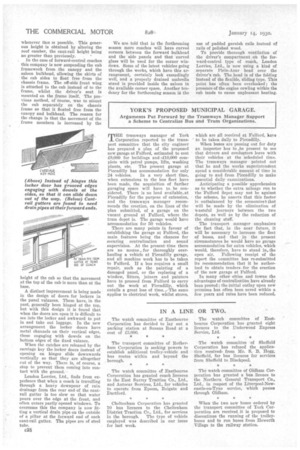COACHWORK FEATURES FOR 1930.
Page 59

Page 60

If you've noticed an error in this article please click here to report it so we can fix it.
Some Ideas in Passenger-vehicle Bodywork Aich a London Coachbuilder is Introducing.
WE have frequently described coaches built by London Lorries, Ltd., of Kentish Town, London, N.W.5, and nearly always they embody some new feature. The company's works are fully engaged now on coaches for the forthcoming season, most 'of them with
the Plein-Azur sliding roof, and we noticed on a recent visit that several interesting features of body design are being snore or less standardized on the latest products.
London Lorries, Ltd., is now arranging for 5 ft. 10 in. gangway headroom c37 whenever this is passible. This generous height is obtained by altering the roof camber, the cant-rail height being no greater than previously. • In the ease of forward-control coaches this company is now suspending the cab framework from the canopy and the saloon bulkhead, allowing the skirts of the cab sides to float free from the chassis frame. The off-side front wing is attached to the cab instead of to the frame, whilst the driver's seat is mounted on the frame itself. The previous method, of course, was to mount the cab separately on the chassis frame so that it floated free from the canopy and bulkhead. The reason for the change is that the movement of the frame members is increased by the height of the cab so that the movement at the top of the cab is more than at the base.
A distinct improvement is being made in the design of doors for lockers in the panel valances. These have, in the past, generally been hinged at the top, but with this design it is found that when the doors are open it is difficult to see into the locker and awkward to put in and take out luggage. In the new arrangement the locker doors have metal channels on their vertical edges, these engaging with dowels on the bottom edges of the fixed valance.
When the catches are released by the carriage key the locker doors instead of opening on hinges slide downwards vertically so that they are altogether Cut of the way. There is, of course, a stop to prevent them coming into contact with the ground.
London Lorries, Ltd., finds from experience that when a coach is travelling through a heavy downpour of rain drainage from the rear end of the contrail gutter is too sIow so that water pours over the edge at the front, and often enters partly opened windows. To overcome this the company is now fitting a vertical drain pipe on the outside of a pillar at the forward end of each cant-rail gutter. The pipes are of steel tube.
C38
We are told that in the forthcoming season more coaches will have curved corners between the forward bulkhead and the side panels and that curved glass will be used for the corner windows. Some of the latest vehicles going through the works, which have this arrangement, certainly look exceedingly well, and a properly drained umbrella stand is provided inside the saloon in the available corner space. Another tendency for the forthcoming season is the
use of padded garnish rails instead of rails of polished wood.
To provide thorough ventilation of the driver's compartment on the forward-control type of coach, London Lorries, Ltd., is now using a kind of separate Plein-Azur head over the driver's cab. The head is of the folding instead of the flexible, sliding type. This point has often been overlooked ; the presence of the engine cowling within the cab tends to cause unpleasant heating.












































































































